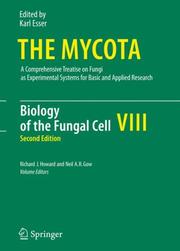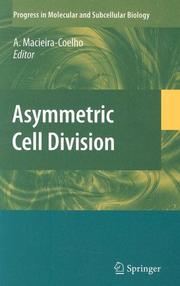| Listing 1 - 10 of 70 | << page >> |
Sort by
|

ISBN: 9783540706151 9783540706182 Year: 2007 Publisher: Berlin Heidelberg Springer-Verlag GmbH.
Abstract | Keywords | Export | Availability | Bookmark
 Loading...
Loading...Choose an application
- Reference Manager
- EndNote
- RefWorks (Direct export to RefWorks)
Mycology, the study of fungi, originated as a subdiscipline of botany and was a descr- tive discipline, largely neglected as an experimental science until the early years of this century. A seminal paper by Blakeslee in 1904 provided evidence for sel?ncompatib- ity, termed heterothallism , and stimulated interest in studies related to the control of sexual reproduction in fungi by mating-type speci?cities. Soon to follow was the demonstration that sexually reproducing fungi exhibit Mendelian inheritance and that it was possible to conduct formal genetic analysis with fungi. The names Burgeff, Kniep and Lindegren are all associated with this early period of fungal genetics research. These studies and the discovery of penicillin by Fleming, who shared a Nobel Prize in 1945, provided further impetus for experimental research with fungi. Thus began a period of interest in mutation induction and analysis of mutants for biochemical traits. Such fundamental research, conducted largely with Neurospora crassa,led to theone gene: one enzyme hypothesis and to a second Nobel Prize for fungal research awarded to Beadle and Tatum in 1958. Fundamental research in biochemical genetics was extended to other fungi, especially to Saccharomyces cerevisiae, and by the mid-1960s fungal systems were much favored for studies in eukaryotic molecular biology and were soon able to compete with bacterial systems in the molecular arena.
Fungi --- Mycology --- Cell biology --- Treatises
Book
ISBN: 9780199652471 Year: 2015 Publisher: Oxford Oxford University Press
Abstract | Keywords | Export | Availability | Bookmark
 Loading...
Loading...Choose an application
- Reference Manager
- EndNote
- RefWorks (Direct export to RefWorks)
1: Introducing the cell: structure, molecular construction and communication strategies, Dr David Furness and Dr Carole Hackney 2: Studying cells: essential techniques, Dr Gavin Knight 3: Anatomy, embryology, and cell families, Dr Ian Locke and Dr. Joanne Murray 4: Blood cell genesis: red cell and white cell families, Dr Gavin Knight 5: Nerves: the cells of the central and peripheral nervous system, Dr Rosalind King and Richard Mathias 6: Lungs: the cells of the respiratory system, Behdad Shambayati 7: The alimentary canal, Tony Warford and Tony Madgwick 8: The cells and commensal bacteria of the alimentary canal, Dr Kathy Nye 9: The cells of the vascular and lymphatic systems, Dr Andrew Blann 10: Connective tissue, bones, cartilage and muscle, Dr Suha Deen 11: The cells of the liver, Anne Rayner and Dr Alberto Quaglia 12: The cells of the kidney, Guy Orchard, David Muskett and Brian Nation 13: Reproductive cells and gametogenesis, Andrew Evered and Behdad Shambayati 14: The endocrine system, Ms Judy Brincat 15: The cells of the skin, Dr Guy Orchard
Histology. Cytology --- cytologie --- Cells --- Cell Physiological Phenomena --- Cellules --- cytology --- Cytologie. --- Physiologie --- Physiologie. --- Cell Physiological Phenomena. --- moleculaire biologie --- Menselijk lichaam --- cytology.

ISSN: 00796484 ISBN: 9783540691617 9783540691600 354069160X 3642088651 3540691618 Year: 2007 Volume: 45 Publisher: Berlin, Heidelberg Springer Berlin Heidelberg
Abstract | Keywords | Export | Availability | Bookmark
 Loading...
Loading...Choose an application
- Reference Manager
- EndNote
- RefWorks (Direct export to RefWorks)
Cell biologists have recently become aware that the asymmetry of cell division is an important regulatory phenomenon in the fate of a cell. During development, cell diversity originates through asymmetry; in the adult organism asymmetric divisions regulate the stem cell reservoir and are a source of the drift that contributes to the aging of organisms with renewable cell compartments. Because of the concept of semi-conservative DNA synthesis, it was thought that the distribution of DNA between daughter cells was symmetric. The analysis of the phenomenon in cells during mitosis, however, revealed the asymmetry in the distribution of the genetic material that creates the drift contributing to aging of mammals. On the other hand, cancer cells can originate from a deregulation of asymmetry during mitosis in particular during stem cell expansion. The book describes the phenomenon in different organisms from plants to animals and addresses its implications for the development of the organism, cell differentiation, human aging and the biology of cancers.
embryologie (geneeskunde) --- histologie --- Histology. Cytology --- Oncology. Neoplasms --- General embryology. Developmental biology --- oncologie --- cytologie --- Cell division --- Cell differentiation --- Genetic recombination --- Symmetry (Biology) --- Biodiversity --- Cellules --- Recombinaison génétique --- Molecular aspects --- Genetic aspects --- Division --- Life Sciences --- Biology --- Molecular biology --- Biologie moléculaire --- Biologie moléculaire --- MDBIOCHE --- Cell differentiation. --- Cell division. --- Developmental biology. --- Cytology. --- Oncology. --- Developmental Biology. --- Cell Biology. --- Cancer Research. --- Tumors --- Cell biology --- Cellular biology --- Cells --- Cytologists --- Development (Biology) --- Growth --- Ontogeny --- Cell biology. --- Cancer research. --- Cancer research
Multi
Abstract | Keywords | Export | Availability | Bookmark
 Loading...
Loading...Choose an application
- Reference Manager
- EndNote
- RefWorks (Direct export to RefWorks)
Histologie --- Hormonen --- Sciences and engineering --- biological sciences --- biology --- molecular --- cell --- health sciences --- obstetrics and gynecology --- molecular. --- cell. --- obstetrics and gynecology. --- Biological sciences --- Biology --- Cell. --- Molecular. --- Health sciences --- Obstetrics and gynecology.
Book
ISBN: 9783540938835 3540938834 9781282236189 1282236180 9786612236181 6612236183 Year: 2009 Publisher: Berlin Heidelberg Springer Berlin Heidelberg
Abstract | Keywords | Export | Availability | Bookmark
 Loading...
Loading...Choose an application
- Reference Manager
- EndNote
- RefWorks (Direct export to RefWorks)
The adv antages of those systems are counterbalanced by some important dis- vantages. For one, in heterotrophic and mixotrophic systems high concentrations of organic ingredients are required in the nutrient medium (particularly sugar at 2% or more), associated with a high risk of microbial contamination. How, and to which extent this can be avoided will be dealt with in Chapter 3. Other disadvantages are the difficulties and limitations of extrapolating results based on tissue or cell c- tures, to interpreting phenomena occurring in an intact plant during its development. It has always to be kept in mind that tissue cultures are only model systems, with all positive and negative characteristics inherent of such experimental setups. To be realistic, a direct duplication of in situ conditions in tissue culture systems is still not possible even today in the 21st century, and probably never will be. The organization of the genetic system and of basic cell structures is, however, essentially the same, and therefore tissue cultures of higher plants should be better suited as model s- tems than, e.g., cultures of algae, often employed as model systems in physiological or biochemical investigations. The domain cell and tissue culture is rather broad, and necessarily unspecif ic. In terms of practical aspects, basically five areas can be distinguished (see Figs. 1.1 , 1.2 ), which here shall be briefly surveyed before being discussed later at length.
Biological techniques --- General embryology. Developmental biology --- Plant physiology. Plant biophysics --- Biotechnology --- systematische plantkunde --- biologische technieken --- biotechnologie --- cytologie --- celprocessen --- Plant cell biotechnology. --- Plant cell culture. --- Plant tissue culture. --- Tissue culture --- Cell culture --- Plant cells in biotechnology --- Plant biotechnology
Book
ISBN: 9789463932363 9789089319876 Year: 2020 Publisher: Gent Owl Press
Abstract | Keywords | Export | Availability | Bookmark
 Loading...
Loading...Choose an application
- Reference Manager
- EndNote
- RefWorks (Direct export to RefWorks)
Hoe zijn cellen opgebouwd en hoe functioneren ze los van elkaar of in een context van weefsels, organen of stelsels? Deze kennis is essentieel voor alle studenten die een opleiding volgen in het brede veld van de geneeskunde en gezondheidswetenschappen. Het eerst luik (cytologie) van dit boek focust op de verschillende delen van de cel: het celmembraan, cytoplasma en de celkern. Hoe zijn ze samengesteld en hoe functioneren ze? De auteur legt hierbij de nadruk op het functionele, want vanuit de functie kan op eenvoudige wijze de structuur en de interactie tussen cellen worden bepaald. In het tweede luik (histologie) worden de primaire weefsels onderzocht: epitheel, bind- en steunweefsel (met inbegrip van bindweefsel, kraakbeen, been en vetweefsel), spierweefsel en zenuwweefsel. Dit luik is essentieel als opstap naar deelgebieden anatomie en fysiologie/fysiopathologie. Aan de hand van een didactisch verantwoorde opbouw en ondersteunend beeldmateriaal wordt deze materie inzichtelijk gemaakt voor iedere student.
Celbiologie --- Histologie --- 611-018.1 --- 611-018 --- 611-01 --- 611-01 General anatomy --- General anatomy --- 611-018 Histology. Histogenesis. Tissue --- Histology. Histogenesis. Tissue --- 611-018.1 Cytology. The cell. Cytoplasm. Protoplasm. Vacuolae. Nucleus. Centrosome. Flagellae --- Cytology. The cell. Cytoplasm. Protoplasm. Vacuolae. Nucleus. Centrosome. Flagellae --- Human histology. Human cytology --- Histology --- Cell Biology --- Cellular Biology --- Cytology --- Biologies, Cell --- Biologies, Cellular --- Biology, Cell --- Biology, Cellular --- Cell Biologies --- Cellular Biologies --- Human anatomy --- anatomie --- histologie --- weefselleer --- celbiologie --- celleer --- cytologie
Book
ISBN: 9784431694816 9784431694793 Year: 2007 Publisher: Tokyo Springer
Abstract | Keywords | Export | Availability | Bookmark
 Loading...
Loading...Choose an application
- Reference Manager
- EndNote
- RefWorks (Direct export to RefWorks)
I have been involved in the treatment of chronic renal insuf? ciency for 40 years, beginning with peritoneal dialysis immediately after graduation from medical school in 1965, then with hemodialysis in 1967 after I ? rst experienced it in Kanazawa, and with renal transplantation since 1972, when I was studying in the United States. During this period, the number of dialysis patients has continued to increase rapidly to the present ? gure of 257 765 (at the end of 2005), and with surprising increases in the survival rate. However, new and unexpected pathological conditions have also appeared as complications of long-term dialysis. One of these involves polycystic changes and their malignant transformation in diseased kidneys. Since I have studied these polycystic changes and their malignant transformation for many years, I decided to compile the results of my work in a book. Such conditions of diseased kidneys pose serious problems, particularly in Japan, where renal transplantation is performed very infrequently compared with other countries, and a large number of patients are managed by dialysis over a long period.
Nefrology --- nefrologie --- urologie --- Urology. Andrology --- Kidney, Cystic. --- Renal cell carcinoma. --- Hemodialysis --- Kidney Diseases, Cystic. --- Carcinoma, Renal Cell. --- Renal Dialysis --- urology. --- neoplasms, tumors. --- Complications. --- Adverse effects.
Book
ISBN: 9783642218583 9783642218576 Year: 2012 Publisher: Berlin, Heidelberg Springer Berlin Heidelberg
Abstract | Keywords | Export | Availability | Bookmark
 Loading...
Loading...Choose an application
- Reference Manager
- EndNote
- RefWorks (Direct export to RefWorks)
Kidney Cancer: Principles and Practice is an interdisciplinary textbook that encompasses all clinically relevant aspects of the disease and is designed to be as user-friendly as possible in order to meet the needs of the busy practitioner. To this end, the informative text is complemented by helpful boxed sections that present essential take home' points and patient-oriented cases demonstrating the clinical application of elements discussed in the chapter in question. Original high-quality images, some in color, are included whenever necessary to simplify particularly complex material. The authors are an international group of acknowledged experts in kidney cancer epidemiology, molecular biology, pathology, diagnosis, clinical features, staging, prognostic and predictive factors, surgery, systemic therapy, and emerging investigational approaches, among others. This clinically oriented volume will be of great interest to clinicians, researchers, residents, and fellows, as well as to students and knowledgeable lay people.
Pathology --- Oncology. Neoplasms --- oncologie --- Human medicine --- pathologie --- geneeskunde --- Carcinoma, Renal Cell --- Kidneys --- Renal cell carcinoma --- Reins --- Néphrocarcinome --- therapy. --- Cancer --- Treatment --- Traitement --- EPUB-LIV-FT LIVMEDEC SPRINGER-B

ISBN: 9781588291721 1588291723 9781592598519 9786610358199 128035819X 159259851X Year: 2005 Publisher: Totowa, N.J. : Humana Press,
Abstract | Keywords | Export | Availability | Bookmark
 Loading...
Loading...Choose an application
- Reference Manager
- EndNote
- RefWorks (Direct export to RefWorks)
Cell death, or apoptosis, plays an important role in biological processes and disease and offers special opportunities to develop new therapies for cancer, autoimmune disease, stroke, heart attack, and Alzheimer's disease. In Death Receptors in Cancer Therapy, leading physician-scientists and basic researchers review in depth our latest understanding of the molecular events that regulate cell death, illuminating those molecules that provide targets for agonists or antagonists designed to modulate death signaling for therapeutic purposes. The authors focus on the extrinsic system of death receptors, their regulation and function, and their abnormalities in cancer. Topics of particlar interest include resistance to apoptosis, TRAIL signaling, death receptors in embryonic development, mechanisms of caspase activation, and death receptor mutations in cancer. Additional chapters address death signaling in melanoma, synthetic retinoids and death receptors, the role of p53 in death receptor regulation, immune suppression of cancer, and combination therapy with death ligands. Authoritative and up-to-date, Death Receptors in Cancer Therapy offers a timely compendium of cell death signaling pathways for those seeking either a basic understanding of apoptosis or the knowledge needed to develop new therapeutics that will activate or block death signaling in disease.
Neoplasms --- Cell Death --- Gene Therapy --- Receptors, Tumor Necrosis Factor --- Apoptosis --- Cell receptors --- Cancer --- Cellular signal transduction --- Apoptose --- Récepteurs cellulaires --- Transduction du signal cellulaire --- immunology --- therapy --- methods --- Molecular aspects --- Aspect moléculaire --- Kanker --- Kanker ; moleculaire aspecten --- Apoptosis. --- Cancer -- Molecular aspects. --- Cell receptors. --- Cellular signal transduction. --- Biological Therapy --- Genetic Engineering --- Diseases --- Investigative Techniques --- Cell Physiological Processes --- Receptors, Cytokine --- Cell Physiological Phenomena --- Receptors, Immunologic --- Analytical, Diagnostic and Therapeutic Techniques and Equipment --- Genetic Techniques --- Therapeutics --- Receptors, Cell Surface --- Phenomena and Processes --- Membrane Proteins --- Proteins --- Amino Acids, Peptides, and Proteins --- Chemicals and Drugs --- Methods --- Medicine --- Biology --- Health & Biological Sciences --- Cytology --- Oncology --- Molecular aspects. --- Cellular information transduction --- Information transduction, Cellular --- Signal transduction, Cellular --- Cell membrane receptors --- Cell surface receptors --- Receptors, Cell --- Medicine. --- Oncology. --- Medicine & Public Health. --- Tumors --- Clinical sciences --- Medical profession --- Human biology --- Life sciences --- Medical sciences --- Pathology --- Physicians --- Bioenergetics --- Cellular control mechanisms --- Information theory in biology --- Binding sites (Biochemistry) --- Cell membranes --- Cell death
Book
ISBN: 9783211763100 3211763090 9783211763094 9786612036576 1282036572 3211763104 Year: 2008 Publisher: Vienna : Springer Vienna : Imprint: Springer,
Abstract | Keywords | Export | Availability | Bookmark
 Loading...
Loading...Choose an application
- Reference Manager
- EndNote
- RefWorks (Direct export to RefWorks)
The Golgi apparatus is more than 110 years in the center of interest and scientific debates. This book summarizes the data obtained after development of methods of Golgi complex sub fractionation, molecular biology and microscopy collecting a range of expertise, different points of view and different approaches.
Life Sciences. --- Cell Biology. --- Life sciences. --- Cytology. --- Sciences de la vie --- Cytologie --- Golgi Apparatus. --- Golgi-complex. --- Plant molecular biology. --- Golgi apparatus --- Organelles --- Cytoplasmic Structures --- Cytoplasm --- Intracellular Space --- Cellular Structures --- Cells --- Anatomy --- Golgi Apparatus --- Biology --- Health & Biological Sciences --- Cytology --- Golgi apparatus. --- Golgi bodies --- Golgi elements --- Golgi material --- Cell biology. --- Cell organelles --- Protoplasm --- Cell biology --- Cellular biology --- Cytologists
| Listing 1 - 10 of 70 | << page >> |
Sort by
|

 Search
Search Feedback
Feedback About UniCat
About UniCat  Help
Help News
News